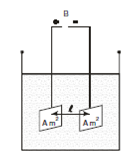Conductance of solutions:
The ease of flow of electric current through a body is called its conductance. In metallic conductors it is caused by the movement of electrons, while in electrolytic solutions it is caused by ions of electrolyte. The electrolytic conductance, G, of a medium is equal to the reciprocal of its electrical resistance R in ohms:
G = 1/R
Ohm's Law states that the current I (amperes) flowing in a conductor is directly proportional to the applied electromotive force E (volts) and inversely proportional to the resistance here R (ohms) of the conductor:
I = E/R or I = EG
Since a solution is a three-dimensional conductor, the exact resistance will depend on the spacing (l) and area (A) of the electrodes. The resistance of a solution in such situation is directly proportional to the distance between the electrodes and inversely proportional to the electrode surface area.
